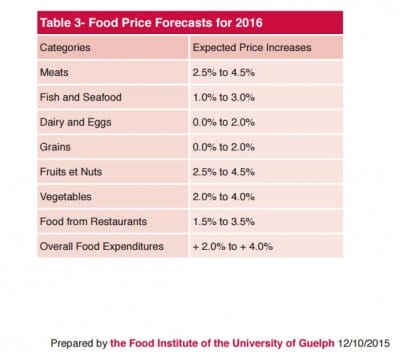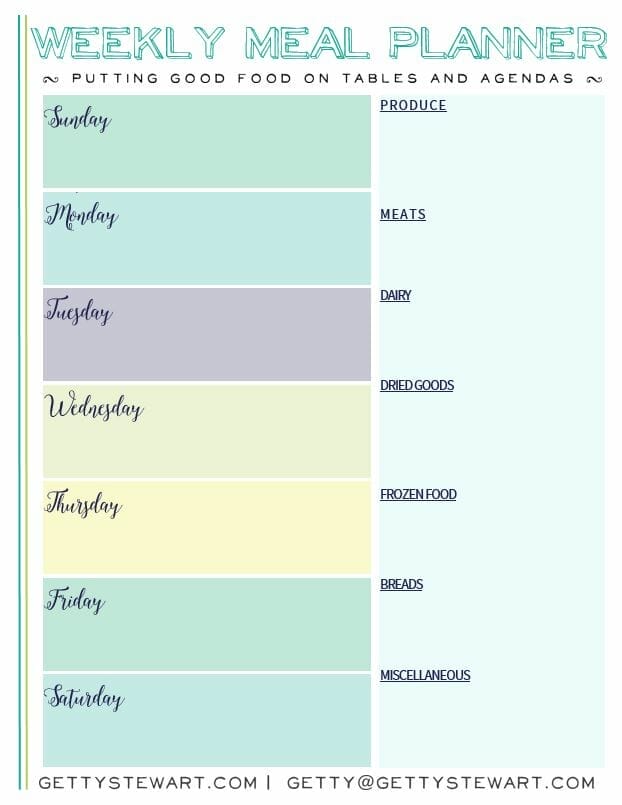Tips for Eating Well With Rising Food Prices
Rising food prices are inevitable. The University of Guelph has released its 2016 Food Price Report sharing their predictions of how food prices will change in 2016. Not surprisingly, the report indicates food prices in Canada will continue to rise. It suggests prices will increase by 2 to 4% – a rate higher than Canada’s general inflation rate.
Read more: 5 More Ways to Save Money on Groceries
Food Price Forecast
All this on top of the 4.1% increase we experienced in 2015. The bottom line for us consumers is that food prices have been and will continue to rise. We’re going to pay more for groceries, but it doesn’t mean we have to sacrifice healthy eating habits. Here are some tips to keep us eating well.
How to Eat Well With Rising Food Prices
In addition to smart shopping strategies like taking advantage of sales, coupons and discount grocery stores, here are a few tips to keep you eating healthy despite rising food prices. I was happy to share these tips with Canadian Press writer Lois Abraham who quoted them in articles published by the Globe and Mail, CBC news, the Financial Post, Maclean’s and several local papers. They were also the topic of conversation on CTV News Morning Live, and on radio with CJOB Winnipeg and 1310 News Ottawa.
1. Make a Meal Plan and Grocery List
Sadly, we often over buy and inadvertently waste food. In fact, the average Canadian household tosses about $1,500 worth of food every year (Univerity of Guelph Food Waste Research Project). Making a meal plan and grocery list can help with rising food prices.
Here’s a handy dandy Weekly Meal Planner and Grocery List that can help you plan your weekly grocery needs.
I admit that meal planning isn’t the most fun activity, but it does make a difference and it only takes a few minutes to jot down a few meal ideas. By mid-week, you’ll be patting yourself on the back for how much easier and affordable feeding your family is with a plan.
2. Use a Combination of Fresh, Frozen and Canned Fruits and Vegetables
Don’t let higher fruit and vegetable prices prevent you from getting your 8-10 servings of Fruits and Veggies. Keep filling Half Your Plate with a variety of delicious, colorful and nutritious produce. To help with the pocket book, shop for frozen and canned fruits and veggies as well as fresh produce. The nutritional content of frozen or canned fruits and vegetables is pretty much equal to and sometimes even better than fresh produce that’s been sitting too long in coolers, transport trucks and warehouses.
3. Eat Seasonally
You’ll get much more value for your dollar when you buy what’s in season. Check out the great variety of fruits and veggies available during the winter season.
Berries, tender fruits and veggies are much more expensive than during their peak season in the summer. It’s tastier and more cost effective to enjoy them fresh during the summer months – try getting them frozen or canned instead.
Leaf lettuce can be pretty expensive in winter months as well. Instead of using leaf lettuce as a base for salads, consider one of these tasty, seasonal winter salads.
Broccoli and Edamame Salad with Soy Ginger Dressing
Orange, Fennel and Celery Salad
Southwestern Black Bean, Corn and Pepper Salad
Fennel and Red Cabbage Coleslaw
Eating seasonally also gives you great variety throughout the year.
During the winter months enjoy pears, apples and citrus fruit along with dark green veggies, winter squash and all sorts of root veggies.
4. Eat Your Leftovers
Seriously, don’t just let them get funky in the fridge – eat them! Make eating leftovers part of your normal family routine, teach your kids that leftovers make a perfectly acceptable meal.
Incorporate leftovers into your meal planning. In fact, plan to make extra so you’re cooking once and eating twice – whoo hoo you just saved time and money!
5. Choose Beans, Lentils and other Pulses More Often
They’re nutritious, delicious, affordable and local.
Did you know we grow some of the world’s best pulses (dry peas, beans, chickpeas, lentils, etc) right here on the Canadian prairies and that the United Nations has proclaimed 2016 the Year of the Pulses? According to the United Nations, “pulses are a vital source of plant-based proteins and amino acids for people around the globe and should be eaten as part of a healthy diet to address obesity, as well as to prevent and help manage chronic diseases such as diabetes, coronary conditions and cancer; they are also an important source of plant-based protein for animals.”
They’re also super affordable and according to the Manitoba Pulse and Soybean Producers “one of the most environmentally-friendly sources of protein, contributing to sustainable food production by protecting and improving soil and water resources.”
It’s definitely a good time to add more pulses to our meal planning. Here’s some inspiration and advice on storing and cooking with pulses. And here’s one of my favorite soups in a jar for you to enjoy.
6. Use Your Freezer
If you can’t get to your leftovers right away or see that you have food reaching its Best Before Date – throw it in the freezer not the trash! Most prepared food freezes quite well – here’s a quick look at what freezes well and what doesn’t.
Foods That Freeze Well
baked goods
unbaked goods
nuts
cooked or scrambled eggs and egg whites (not yolks)
soups & stews
high fat dairy products
firm cheese
fruits and berries
meat (well wrapped)
raw vegetables – must be blanched
Foods That Don’t Freeze Well
egg yolks
gelatin based dishes
sour cream
high moisture vegetables (lettuce, cucumber, etc.)
cooked meats not in a sauce or casserole
Here’s more info on freezing onions, ginger, wine, and eggs.
7. Be “Best Before Date” Savvy
Just because you’ve reached the Best Before date doesn’t mean you have to throw the product out.
Here are the most important things you need to know about Best Before Dates in Canada.
Did you know “Best Before” dates do not guarantee product safety? They provide the manufacturer’s recommendation for the amount of time that an unopened food product under appropriate conditions will keep its freshness, taste and nutritional quality. Think about it, the minute you open your milk jug, the best before date is invalid, so why pay attention to it – use your judgement!
By law, “Best Before” dates and proper storage instructions must appear on pre-packaged foods that will keep fresh for 90 days or less, and are packaged at a place other than the retail store from which they are sold. Items that can be stored for 90 days or more (eg. pasta, nuts, canned goods, etc) do not actually require a Best Before date. Sometimes I wonder if manufacturers are encouraging us to toss and rebuy food by adding Best Before dates – what do you think?
Best Before does not mean Toxic After. Understand best before dates. TWEET This
8. Make Soup
Soup is the ultimate strategy for healthy, affordable eating. Making soup is a creative process that allow you to combine whatever is in the fridge into a delicious, nourishing concoction. Soup was our grandparents way of using whatever was available and making it go a long, long way. We can do the same today.
9. Grow & Preserve Your Own Food
And finally, here’s a more long term strategy – consider growing and preserving some of your own food. You’ll not only get tasty and affordable veggies, but you’ll get a tremendous sense of pride and build a connection to the environment that you can’t even imagine. Now’s the perfect time to plan your garden for next season.
10. Keep Things in Perspective and Think About Those Less Fortunate
There’s no doubt rising food prices are going to hurt at the cash register.
However, I think it’s important to put food prices in perspective. When I think about the value of food, the resources and processes that go into growing, harvesting, processing, packaging, transporting, warehousing, marketing and selling food, I’m actually amazed at how inexpensive our food truly is. Especially considering how critical it is to our survival.
Here’s another way to put rising food prices in perspective. In Canada, the average household spends bout 10% of its annual expenditures on food Stats Canada, 2013 . European countries spend between 11 to 15%, countries like Mexico, Poland and Russia spend over 20% of their annual income on food while countries like Indonesia, Pakistan, Nigeria, Kenya, Belarus spend over 40% of their annual income on food (USDA Economic Research Services, 2008). In comparison to others across the world, we’re doing pretty good.
We’re also doing pretty good when you consider the percent of income our grandparents spent on food. According to Stats Canada, the average Canadian family spent 28% of food in 1961, and 17% in 2007.
The people that will be hardest hit by rising food prices in Canada are those living on low income where the percent of income spent on food is much higher than for those of us with average to high annual incomes. It will also be a hard hit on those living in Northern or remote communities where food prices are considerably higher than in major urban centres. Ensuring everyone has equal access to good quality food is a challenge for all of us. Food security is everyone’s business. As one participant in a recent workshop on Food Security said “No one is food secure unless their neighbours are food secure.”
Want to learn more? How about a Eating Healthy and Affordably All Year workshop with Getty? Or talk to Getty about hands-on workshops for your group. Getty Stewart is an engaging speaker and writer providing tasty recipes, time-saving tips, and helpful kitchen ideas to make home cooking easy and enjoyable. She is a Professional Home Economist, author of Manitoba’s best-selling Prairie Fruit Cookbook, Founder of Fruit Share, mom and veggie gardener.










One Comment